Table of Contents
Serial killers are criminals who commit three or more murders over a considerable period of time, for psychological and psychopathic gratification.
Who Is A Serial Killer?
A serial killer is a type of multicide perpetrator who kills three or more people over a long period of time 1 Dogra, T. D., Leenaars, A. A., Chadha, R. K., Manju, M., Lalwani, S., Sood, M., Lester, D., Raina, A., & Behera, C. (2012). A psychological profile of a serial killer: a case report. Omega, 65(4), 299–316. https://doi.org/10.2190/OM.65.4.d . Modern criminology explains that serial killers display amplified traits of psychopathy 2 Kiehl, K. A., & Hoffman, M. B. (2011). THE CRIMINAL PSYCHOPATH: HISTORY, NEUROSCIENCE, TREATMENT, AND ECONOMICS. Jurimetrics, 51, 355–397. , exhibiting
- shallow affect
- lack of empathy, guilt and remorse
- irresponsibility, and
- impulsivity.
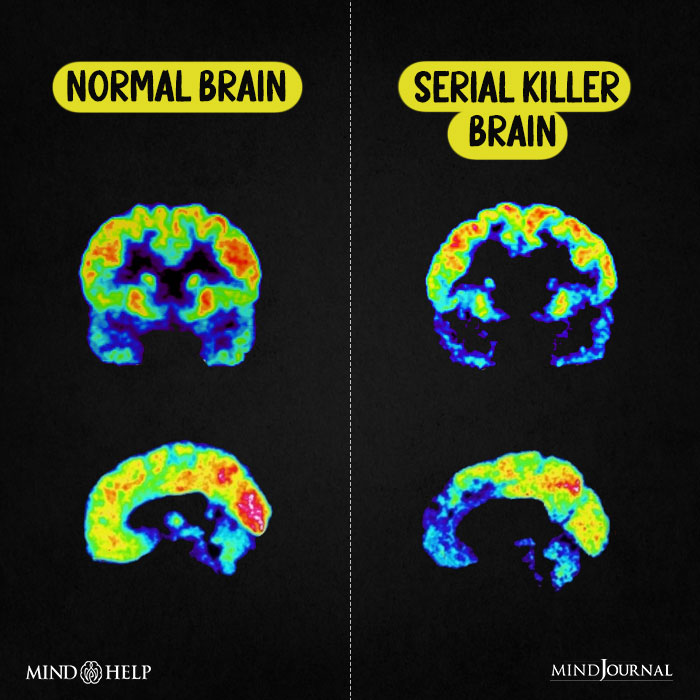
Read More About Guilt Here
What Is Serial Killing?
Serial homicide or killing is a premeditated, consciously perpetrated, voluntary act of violence directed to cause harm or loss of life.
According to a 2020 study 3 Marono, A. J., Reid, S., Yaksic, E., & Keatley, D. A. (2020). A Behaviour Sequence Analysis of Serial Killers’ Lives: From Childhood Abuse to Methods of Murder. Psychiatry, psychology, and law : an interdisciplinary journal of the Australian and New Zealand Association of Psychiatry, Psychology and Law, 27(1), 126–137. https://doi.org/10.1080/13218719.2019.1695517 , serial killing or serial homicide is an all-inclusive term for the “unlawful killing of two or more victims in separate events”. The threshold number of murders 4 Deepak, S. A., & Ramdoss, S. (2021). The Life-Course Theory of Serial Killing: A Motivation Model. International journal of offender therapy and comparative criminology, 65(13-14), 1446–1472. https://doi.org/10.1177/0306624X20981030 in a serial killing range from 3 to 5 but is never less than two.
Serial killers usually don’t stop until they’re either caught by the police or killed. In most cases, they follow a pattern, choosing similar types of victims, using the same methods, and repeating their crimes at certain intervals 5 Pecino-Latorre, M., Pérez-Fuentes, M., & Patró-Hernández, R. M. (2019). Homicide Profiles Based on Crime Scene and Victim Characteristics. International journal of environmental research and public health, 16(19), 3629. https://doi.org/10.3390/ijerph16193629 with respect to their type of victims, killing methods, killing frequency, etc
Serial homicide is often accompanied by other crimes such as rape, burglary, necrophilia, pedophilia, theft, spree killing, etc.
Serial Killing Vs Mass Murder
It is often confused with other types of multicide 6 Marono, A. J., Reid, S., Yaksic, E., & Keatley, D. A. (2020). A Behaviour Sequence Analysis of Serial Killers’ Lives: From Childhood Abuse to Methods of Murder. Psychiatry, psychology, and law : an interdisciplinary journal of the Australian and New Zealand Association of Psychiatry, Psychology and Law, 27(1), 126–137. https://doi.org/10.1080/13218719.2019.1695517 like mass murder, spree-killing, or contract killing. However, despite the conceptual similarities, the acts are essentially different—distinguished by factors 7 Chan, H. C., Beauregard, E., & Myers, W. C. (2015). Single-victim and serial sexual homicide offenders: differences in crime, paraphilias and personality traits. Criminal behaviour and mental health : CBMH, 25(1), 66–78. https://doi.org/10.1002/cbm.1925 like:
- Timeline
- Number of homicides
- Number of victims
- Killing methods
- Motives
- Others
For instance, mass murder is four or more murders occurring at one event without any distinctive time lapse between them. On the other hand, spree-killing is any murder that occurs at two or more locations with no emotional cooling-off period in-between.
In contrast, the sure signs of a serial killer comprise murdering three or more people, with cooling-off periods in-between, over a lengthy stretch of time.
The Psychology Behind Serial Killing
A question that intrigues most people is: How do serial killers think? What makes them kill?
In a majority of cases, crime experts attribute this psychopathy to harrowing developmental experiences 8 Marono, A. J., Reid, S., Yaksic, E., & Keatley, D. A. (2020). A Behaviour Sequence Analysis of Serial Killers’ Lives: From Childhood Abuse to Methods of Murder. Psychiatry, psychology, and law : an interdisciplinary journal of the Australian and New Zealand Association of Psychiatry, Psychology and Law, 27(1), 126–137. https://doi.org/10.1080/13218719.2019.1695517 and mental deterioration . Such experiences hark back to:
- Childhood abuse
- Early separation from mother
- Sexual abuse
- Domestic violence
- Poverty
- Social or romantic failures, etc.
More often than not, serial killers act on motives 9 Myers, W. C., Husted, D. S., Safarik, M. E., & O’Toole, M. E. (2006). The motivation behind serial sexual homicide: is it sex, power, and control, or anger?. Journal of forensic sciences, 51(4), 900–907. https://doi.org/10.1111/j.1556-4029.2006.00168.x drawn from:
- Anger
- Thrill-seeking
- Lust
- Profit or power seeking
- Need for attention
- Financial gain 10 Myers, W. C., Husted, D. S., Safarik, M. E., & O’Toole, M. E. (2006). The motivation behind serial sexual homicide: is it sex, power, and control, or anger?. Journal of forensic sciences, 51(4), 900–907. https://doi.org/10.1111/j.1556-4029.2006.00168.x
- Fulfilling a delusional goal, etc.
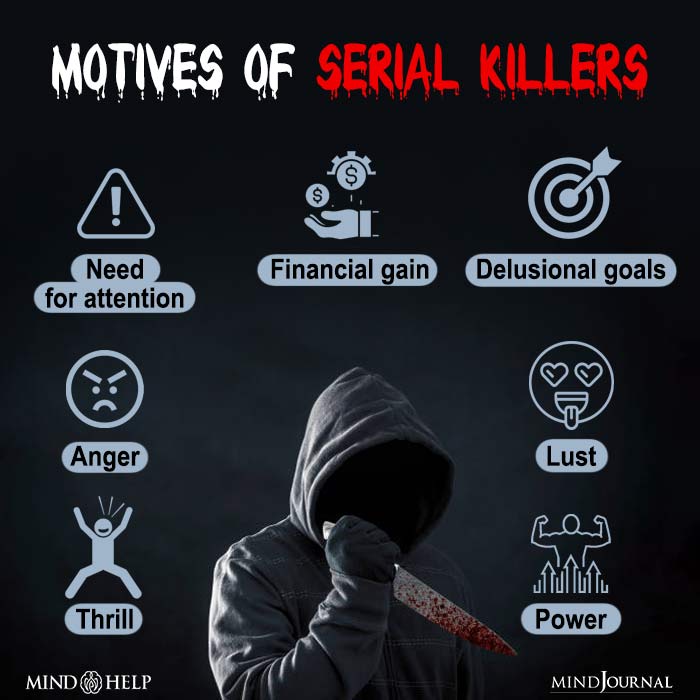
Read More About Anger Here
No matter what their motive is, all serial killers ultimately kill for the sake of killing. Sometimes they pick their victims at random, while other times they target people who match their personal idea of the “perfect victim”, often based on things like race, gender, or appearance.
Most serial killers, during trial, have been medically evaluated and popularly speculated to be suffering from serious mental health conditions. However, even if serial killers are considered mentally unstable 11 Rath, N. M., & Dash, B. (1990). A study on insanity related homicide. Indian journal of psychiatry, 32(1), 69–71. , they are not adjudicated as such under the law.
Traits Of A Serial Killer
The time-tested Macdonald triad, 12 Parfitt, C. H., & Alleyne, E. (2020). Not the Sum of Its Parts: A Critical Review of the MacDonald Triad. Trauma, violence & abuse, 21(2), 300–310. https://doi.org/10.1177/1524838018764164 formulated in 1963 by the renowned psychiatrist J. M. Macdonald’s theory continues to be referenced in modern times to assess or identify potential violent criminal behavior, particularly in cases related to serial homicide.
According to the triad of sociopathy, the early indicators of a potential serial killer can often be observed during childhood 13 Johnson, B. R., & Becker, J. V. (1997). Natural born killers?: the development of the sexually sadistic serial killer. The journal of the American Academy of Psychiatry and the Law, 25(3), 335–348. are already present in childhood. These warning signs of a serial killer typically include:
- Arson, or setting fires
- Cruelty to animals
- Enuresis, or unintentional bed-wetting during sleep
However, the Macdonald triad has seen much flexibility and elaboration in recent years, thanks to rigorous in-field practices in criminology and forensic studies. Recent research 14 García-Baamonde, M. E., Blázquez-Alonso, M., Moreno-Manso, J. M., Guerrero-Barona, E., & Guerrero-Molina, M. (2022). Youth Serial Killers: Psychological and Criminological Profiles. International journal of environmental research and public health, 19(9), 5359. https://doi.org/10.3390/ijerph19095359 throws light on the characteristics of a serial killer, which include:
- Signs of psychopathy
- Egocentrism
- Grandiose and sadistic ideas of pleasure
- Being cruel, ruthless, and remorseless
- Having no or shallow emotions
- Lack of basic human values (like empathy)
- Lack of responsibility for their crimes
- Superficial charm
- Deceitful, and manipulative behavior
- Poor conduct control (like impulsivity, recklessness, etc.)
- Tendencies related to vandalism, arson, theft, etc.
- Extreme risk-taking behavior.
Rsearch has found that many serial killers were diagnosed with mental health conditions, such as:
- Antisocial personality disorder
- ADHD [Read More]
- Narcissistic personality disorder [Read More]
- Substance abuse disorders
- Schizophrenia [Read More]
- Psychosis [Read More], etc
Types Of Serial Killers
Based on their ‘human’ characteristics, serial killers are primarily distinguished into two major types 15 Promish, D. I., & Lester, D. (1999). Classifying serial killers. Forensic science international, 105(3), 155–159. https://doi.org/10.1016/s0379-0738(99)00123-1 :
1. Organized Killers
Organized killers are calculated and deliberate, often planning their crimes in advance to avoid detection and eliminate evidence. They usually choose victims based on specific obsessions or fantasies and may engage in behaviors like fetishism, necrophilia, partialism, or collecting human trophies. Such killers often target children, young women, homosexual men, and couples.
2. Unorganized Killers
Unorganized killers typically do not plan their crimes in advance, and their actions are often erratic and impulsive. Their killings tend to be chaotic in nature, often driven by severe underlying mental health issues that fuel their violent behavior.
While they lack structured planning, unorganized killers still exhibit patterns in their victim selection—often choosing locations at random but consistently targeting specific social groups.
Both organized and unorganized serial killers can further be categorized based on the underlying motives behind their homicidal behavior 16 Promish, D. I., & Lester, D. (1999). Classifying serial killers. Forensic science international, 105(3), 155–159. https://doi.org/10.1016/s0379-0738(99)00123-1 . These include:
1. Visionary Killers
A visionary serial killer is driven by intense, often delusional beliefs rooted in personal visions or hallucinations. These distorted perceptions frequently stem from an unstable mental state and are typically tied to grandiose religious ideologies, occult involvement, or ritualistic practices. The killer may believe they are chosen or commanded by higher powers to commit murder as part of a divine or supernatural mission.
Notable examples include Herbert Mullin and Richard Chase, both of whom carried out a series of murders in the 1970s that they believed were necessary blood sacrifices.
2. Mission-oriented Killers
Mission-oriented serial killers believe it’s their duty to eliminate certain groups of people. They often target others based on race, religion, or personal beliefs, thinking they are “cleansing” society.
One example is Joseph Paul Franklin, who killed Black people, Jewish individuals, and interracial couples in the U.S. between 1977 and 1980.
3. Hedonistic killers
Hedonistic serial killers kill for pleasure. Their motivation can come from excitement, sexual desire, or the hope of gaining something valuable like money. This type of killer is driven by personal satisfaction.
There are three main types of hedonistic killers:
- Lust Killers: These killers are sexually driven. They may torture, rape, or mutilate their victims for their own gratification. Examples include Ted Bundy and John Wayne Gacy, also known as the “Killer Clown.”
- Thrill Killers: Thrill killers murder for the excitement of the act itself. They enjoy the fear and control they have during the process, often involving stalking or threatening victims. Robert Hansen, who killed several women in Alaska from 1980 to 1983, is a known case.
- Comfort Killers: These killers murder for material or financial gain. One famous comfort killer was Dr. H.H. Holmes, who lured victims into his Chicago “Murder Castle” in the late 1800s to benefit from their deaths.
4. Killers Seeking Power/Control
Power/control killers are motivated by the desire to dominate their victims completely. They often enjoy the feeling of being in control and may use sexual violence, torture, or even keep body parts as “trophies” to relive the experience.
A well-known example is the Zodiac Killer, who operated in California during the 1960s and used fear, threats, and mysterious messages to assert power over both victims and the public.
Serial Killer Myths
Serial killers and their crimes continue to capture people’s attention through stories, documentaries, and even dark obsessions. Many are drawn to the shocking murder methods, the disturbing minds behind the crimes, the ways they avoid getting caught, and what happens after, like arrest, trial, and punishment.
Still, most serial killer cases have attracted intense media attention, often leading to stereotypes and sensationalized stories. Over time, this has created many myths and false or exaggerated ideas.
Here are some of the most common myths about serial killers:
1. All serial killers are men.
Serial killers can be both men and women, even though female serial killers are rare compared to their male counterparts. In some cases, because of the meticulous documentation of modern-day serial killers in the US, it is widely believed that serial killers are mostly white men. This is not true.
For instance, a 2006 study 17 Frei, A., Völlm, B., Graf, M., & Dittmann, V. (2006). Female serial killing: review and case report. Criminal behaviour and mental health : CBMH, 16(3), 167–176. https://doi.org/10.1002/cbm.615 claims that, compared to 77% of male serial killers, female serial killers amount to 23%. It was also found that the most common motive for men was material gain or similar extrinsic gratification while women rarely were ‘hedonistic’ killers, who killed for sexual gratification.
2. All serial killers have an above-average IQ.
It is widely believed that serial-killers are geniuses with an IQ level above the average person. Instead, it is found that serial killers are in reality, people of average intelligence with enhanced streaks of psychopathy 18 Myers, W. C., Gooch, E., & Meloy, J. R. (2005). The role of psychopathy and sexuality in a female serial killer. Journal of forensic sciences, 50(3), 652–657. .
3. All serial killers are motivated by sex.
It is a popular notion that all serial killings are lust killings. This is a predominant generalization, as serial homicide is motivated by several causes (such as material gains, visions, the thrill of adventure, etc.)
4. All serial killers can’t stop killing.
Many people believe that serial killers don’t stop until they’re either caught or killed. But in some cases, like the Zodiac Killer, they seem to stop on their own, without being arrested or dying.
5. All serial killers have mental health conditions.
Criminal psychology always strives to locate the motive of this type of killing in the murky minds of the perpetrators. Experts try to signal out certain mental disorders—like schizophrenia, ADHD, psychosis, antisocial personality, and narcissistic disorders—that appear to contribute to the killing spree and associated wicked acts.
They have tried to trace and recognize the source of such mental health conditions, like childhood abuse, trauma, parental violence, bullying, etc. Hence, more often than not, people consider serial killers as “social casualties”. They fail to see that serial killers mostly kill for the sake of killing itself.
6. All serial killers want to get caught.
Many people think serial killers, who are too knee-deep in crime, get deranged and long to be discovered so as to put an end to their killing spree. However, as case studies show, all criminals do not long to be caught. They take extreme care to escape the consequences of their actions and that is why when they get caught—it is usually by accident.
An Infamous Serial Killers List
Some of the worst and infamous serial killers in history include:
1. Jack The Ripper
Jack the Ripper is one of the most infamous serial killers in modern history. He terrorized Victorian London in the 1880s, targeting and brutally killing at least five women, all believed to be prostitutes. Though his identity was never discovered, his crimes sparked countless myths and urban legends that continue to this day.
2. Ted Bundy
Perhaps the most notorious of male serial-killers, Theodore “Ted” Bundy was charged with lust serial killing of at least 30 women, across 5 American states, between 1973 and 1978. In prison, he was diagnosed with antisocial personality disorder and mania as he exhibited different appearances, signatures, names, and criminal methods at different times.
3. Vera Renczi, “The Black Widow”
The most famous female serial killer, Vera Renczi or “The Black Widow” was a Romanian serial killer who killed 35 men by arsenic poisoning. Her victims included her husbands, her lovers, and her children.
Other Notable Mentions Include:
- The Zodiac
- The Stoneman
- Aileen Wuornos
- George Beltrao Negramonte
- John Wayne Gacy (“The Killer Clown”)
- Pedro Lopez (“The Monster of the Andes”)
- Harold Shipman (“Dr Death”)
- Béla Kiss, who pickled his victims in alcohol
- The Joshi-Abhyankar serial murderers
- Peter Sutcliffe, “The Yorkshire Ripper”
- Joachim Kroll, “The Ruhr Cannibal”
- Amir Qayyum, “The Brick Killer”
- Sleepy Hollow Killer
Takeaway
More often than not, what we know of serial killers are products of colorful storylines and headlines. These were directed to create “larger than life” socially constructed “celebrity monsters” who reduced the severity of their criminal actions into stylish “wickedness” and piqued newspaper sales.
Nonetheless, this “wickedness”—time and again—poses significant investigative challenges to law enforcement, not to mention attracting an over-abundance of attention from the media, mental health experts, academia, and the general public.
At A Glance
- Serial killers are criminals who commit more than 3 murders over a considerable period of time.
- They act on motives drawn from anger, thrill-seeking, attention-seeking, financial gain, fulfilling a delusional goal, etc.
- Most serial killers have a history of abuse, neglect and/or mental health conditions.
- The characteristics of serial killers include psychopathy, impulsive behavior, lack of remorse, manipulative tendencies, risk-taking behavior, etc.
- Most serial-killers follow a pattern in their type of victims, killing methods, killing frequency, etc.
- Cases of serial killers are sensationalized by the media. Resultantly, what we know of them is based on myth and speculation.
Frequently Asked Questions (FAQs)
1. What are some best movies about serial killers?
Psycho, Last Night In Soho, Henry: Portrait of a Serial Killer, The Texas Chain Saw Massacre, Zodiac, and The Silence of the Lambs, are some well known movies about serial killers.
2. Is serial killing a mental illness?
While serial killers are linked to a bevy of mental disorders during the trial, most of them are not adjudicated as insane under the law. The tendency of killing may have its origin in mental health conditions in some criminals, but it in itself is not a mental illness.
3. Are all serial killers psychopaths?
All psychopaths are not serial killers, but all serial killers are psychopaths. They possess traits consistent with psychopathy. These get amplified during their killing sprees and other criminal activities.
4. Do serial killers love their families?
Case studies show that serial killers exhibit protective and loving behavior towards their own families, even when they are killing other people. They usually lack basic humanistic and social values like empathy, respect for life, guilt, etc., and put on a superficial mask of humanity as they go on with their criminal activity.
5. How do serial killers select their victims?
They select their victims based on their fantasy of the “ideal victim” and certain social reservations based on race, gender, physical characteristics, etc.
6. Who are some famous serial killers with bipolar disorder?
Anthony Hardy, Ted Bundy, Tommy Lynn Sells, and Gary Lee Sampson are some famous killers with the mental health condition, bipolar disorder.

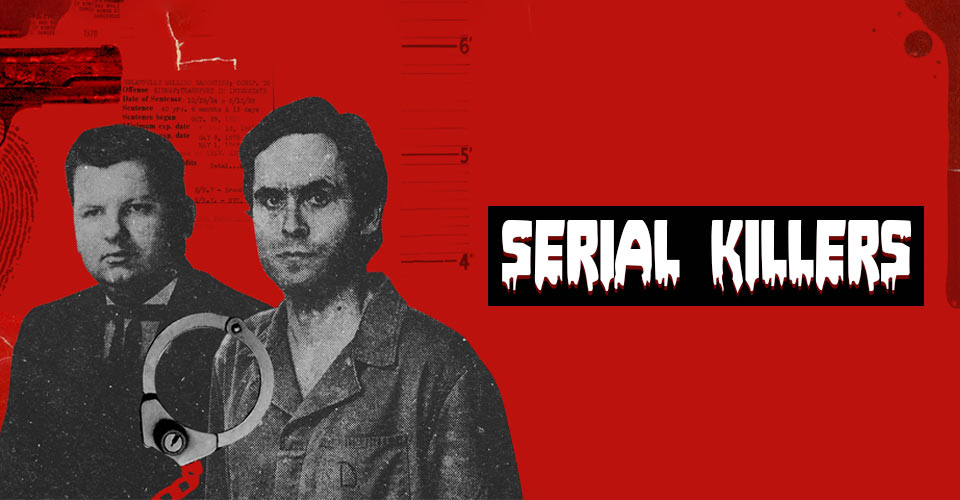

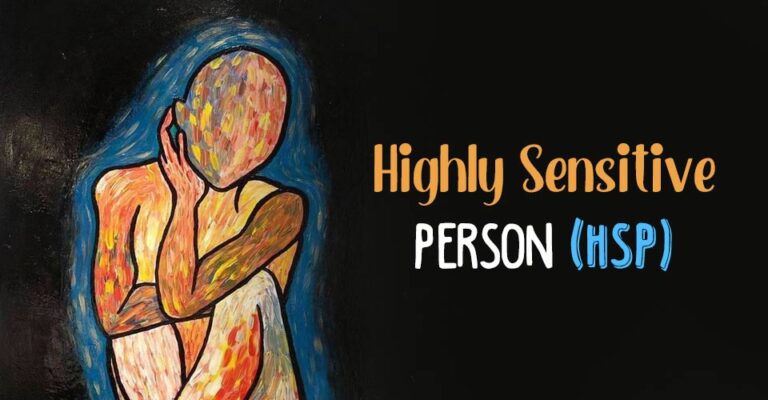

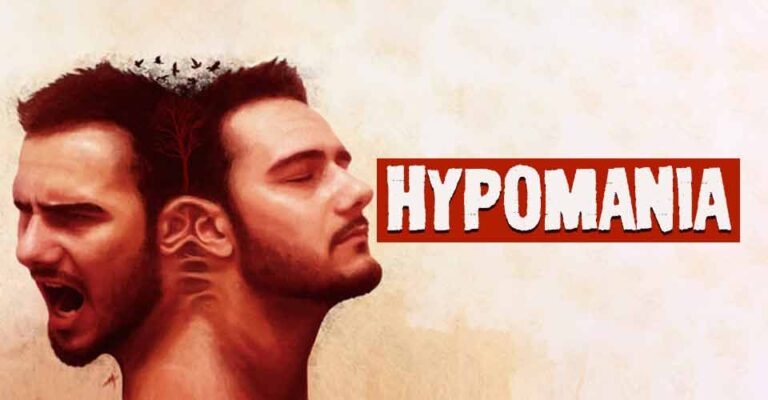
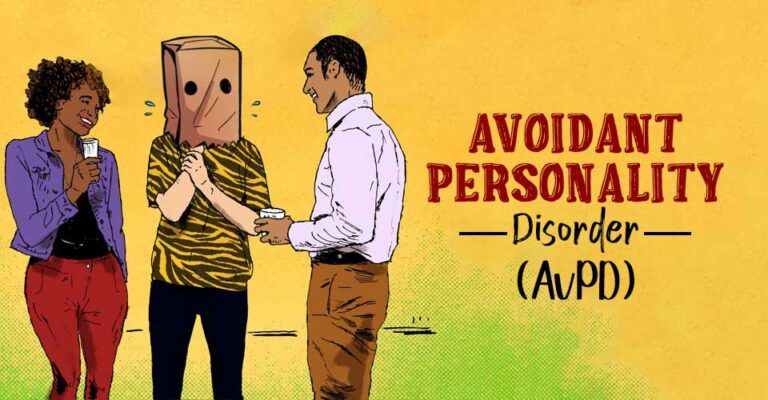

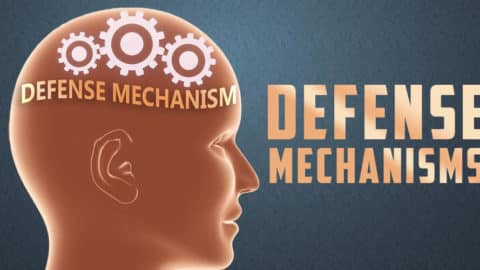
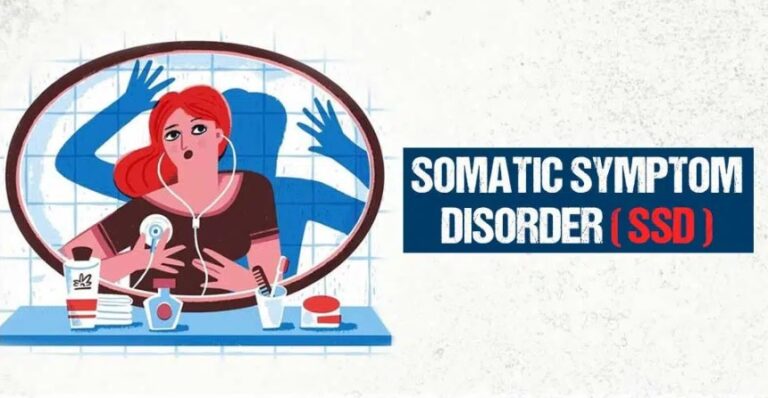
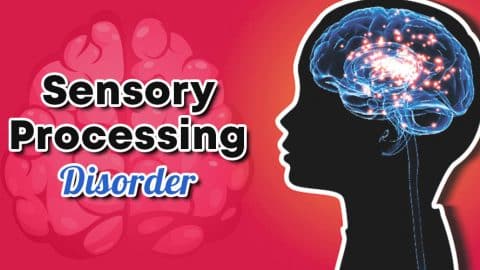

I have had my suspicions of certain people. I feel unsafe and not sure who people are